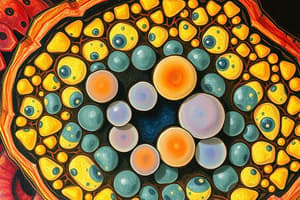Podcast
Questions and Answers
What do lysosomes contain?
What do lysosomes contain?
enzymes that digest non usable materials within the cell
Which organelle is known as the 'powerhouse' of the cell?
Which organelle is known as the 'powerhouse' of the cell?
- Peroxisomes
- Mitochondria (correct)
- Lysosomes
- Nucleus
Peroxisomes are involved in the detoxification of harmful substances.
Peroxisomes are involved in the detoxification of harmful substances.
True (A)
The ______ directs the formation of the mitotic spindle during cell division.
The ______ directs the formation of the mitotic spindle during cell division.
What are the three regions of the nucleus?
What are the three regions of the nucleus?
Which type of organism has a membrane-bound nucleus?
Which type of organism has a membrane-bound nucleus?
______ is composed of DNA and protein and is scattered throughout the nucleus.
______ is composed of DNA and protein and is scattered throughout the nucleus.
How do eukaryotic DNA typically differ from prokaryotic DNA?
How do eukaryotic DNA typically differ from prokaryotic DNA?
Flashcards are hidden until you start studying
Study Notes
Lysosomes
- Contain enzymes responsible for digesting non-usable cellular materials.
Peroxisomes
- Membranous sacs filled with oxidase enzymes.
- Detoxify harmful substances and dismantle free radicals.
- Replicate by pinching in half.
Mitochondria
- Known as the "powerhouses" of the cell.
- Continuously change shape.
- Perform oxygen-dependent reactions to break down food.
- Generate ATP, the primary energy currency of the cell.
Cytoskeleton
- Composed of a network of protein structures throughout the cytoplasm.
- Functions as the internal framework of the cell.
- Consists of three types of filaments:
- Microfilaments (2mm) made of actin subunits.
- Intermediate filaments (10m) with fibrous subunits.
- Microtubules (25mm) formed from tubulin subunits.
Centrioles
- Rod-shaped structures made of microtubules.
- Play a crucial role in directing the formation of the mitotic spindle during cell division.
Nucleus
- Acts as the control center of the cell.
- Houses genetic material (DNA) and consists of three main regions:
- Nuclear membrane.
- Nucleolus.
- Nucleoplasm.
Nuclear Membrane
- A double phospholipid membrane that serves as a barrier for the nucleus.
- Contains nuclear pores for material exchange with the cytoplasm.
Nucleoli
- The nucleus contains one or more nucleoli, essential for ribosome production.
- Ribosomes migrate to the cytoplasm through the nuclear pores.
Nucleoplasm
- Surrounds the nucleus, embedding chromatin which is a folded form of DNA and histones.
Chromatin
- Comprises DNA and proteins scattered within the nucleus.
- Condenses into chromosomes during cell division.
Prokaryote vs. Eukaryote
-
Prokaryote (unicellular):
- Lacks a membrane-bound nucleus; genetic material is in a nucleotide region.
- Unicellular and smaller than eukaryotes, averaging 1-5 microns in size.
- DNA is single and circular.
-
Eukaryote (multicellular):
- Has a membrane-bound nucleus enclosing genetic material.
- DNA is linear and present in multiple copies within the nucleus.
- Typically larger, with an average size of ~10-100 microns.
Studying That Suits You
Use AI to generate personalized quizzes and flashcards to suit your learning preferences.



